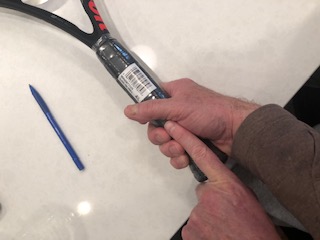The correct grip size makes all the difference in comfort and performance. When the grip is too large or too small the muscles in your forearm has to work that much harder to stabilize the racquet. This leads to fatigue and sometimes, soreness – often referred to as tennis elbow or tendinitis.
To find your correct grip size, you need to be able to place the index finger of your non dominant hand in the space between the heal of your hand and your fingertips of the hand holding the grip. (usually holding a continental or eastern forehand grip).

Players with topspin ground strokes find that using a slightly smaller grip allows for a looser – more relaxed grip and improved racquet head speed. Players with flatter strokes find that a larger grips aids in racquet stability.
Players with elbow issues might consider using a slightly larger grip or adding an overgrip to their grip to help relieve pressure that comes from holding a grip too tightly.
If a player is between grip sizes – we suggest going with the smaller grip size as it is easier to build up than reduce a grip size.
Building up a grip if necessary.
The simplest method is an overgrip. It adds about a 1/16 inch.
Another option is to increase the pallet size with a build-up sleeve, and these are available in both 1/16 and 1/8 increments to allow a racquet technician to tailor a grip to a player’s needs. We don’t recommend endless build up sleeves and suggest adding no more than two because the handle will start to lose its shape, making it difficult to feel the various grips used whilst playing. This method will also add extra weight to a racquet.
The last method is replacing the original grip with a thicker or thinner version. Many racquet brands like Wilson and Babolat make a variety of grip types to reduce or enlarge a grip by a 1/6 inch and this can make all the difference. Using a thinner replacement allows a player to then add an overgrip to bring a grip size back to its original size.
